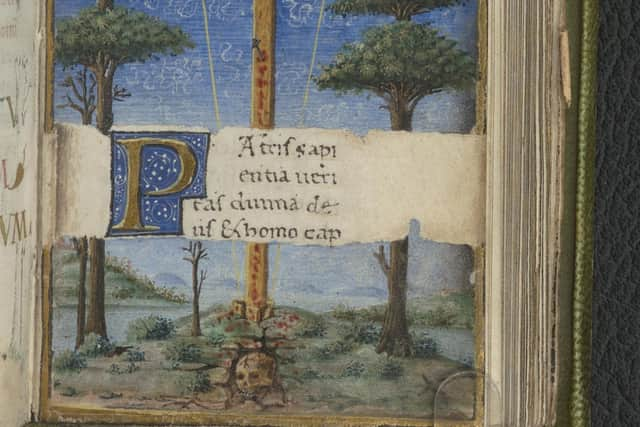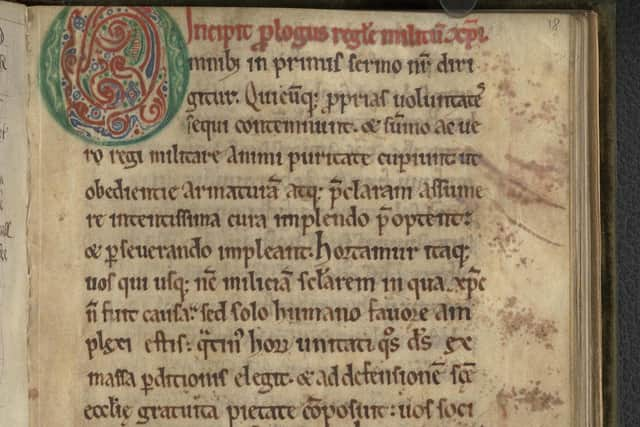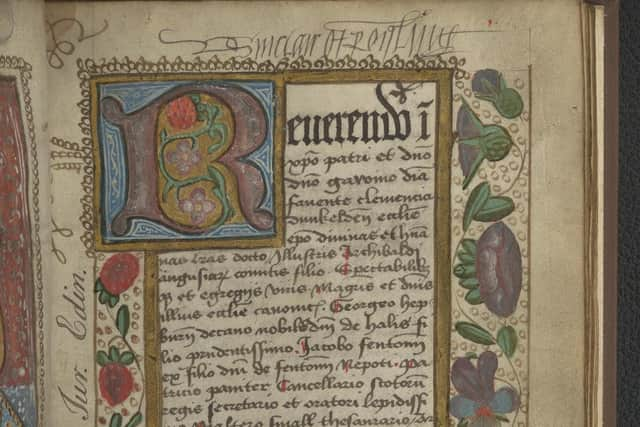Rare ancient script advising Knights Templar crusaders how to wear facial hair can now be seen online at National Library of Scotland
and live on Freeview channel 276
The ancient publication is part of a fascinating collection of more than 240 textual relics from across the world, including illuminations, medieval doodles and zodiac medical material that have been recently digitised by the National Library of Scotland (NLS) and are now available for virtual viewings.
Among the books are volumes produced in Scotland, England, France, Italy and north-west Europe, as well as Greece and Iceland.
Advertisement
Hide AdAdvertisement
Hide AdMany are finely decorated or of major textual significance, with items dating from the ninth to 16th centuries.
A few later transcriptions of important texts are also included.
The Scottish manuscripts – such as a 15th-century psalter written and illuminated at Culross Abbey in Fife and an early 16th-century manuscript detailing the lives of the bishops of Dunkeld – are among the rarest.
The resource includes manuscripts on a range of subjects, such as medicine and the rule of Knights Templar – an ancient order of Christian crusaders often linked with myths and conspiracies, brought to public attention in popular modern fiction such as the Indiana Jones and the Last Crusade film, as well as rare survivors of the Reformation.


Advertisement
Hide AdAdvertisement
Hide AdNLS manuscripts curator Dr Ulrike Hogg said: “This fascinating digitised collection is international in origin, though a large part of the volumes were written in Scotland.
“The survival rate of medieval Scottish manuscript volumes is generally low.
“For example, only 1 per cent of religious manuscripts of Roman Catholic use – many of which were systematically destroyed during and after the Scottish Reformation – are believed to still be in existence.
“It is difficult to estimate how many cultural treasures were lost during these times.


Advertisement
Hide AdAdvertisement
Hide Ad“The collection presented here includes a number of those fortunate survivors that have endured subsequent centuries.
“We’re delighted to make these extremely rare pieces of history publicly accessible online.”
Other notable pieces include a tiny 15th-century Book of Hours from Italy with lavish gold illumination; a folded medical/zodiac almanac from the same period, which probably belonged to a doctor based in northern England and could be worn on a belt; and a selection of historical doodles showing rich period detail.


Dr Hogg said: “The digital images provide a new opportunity to gain some insight into medieval Scottish book production.
Advertisement
Hide AdAdvertisement
Hide Ad“The interests, tastes and knowledge of medieval scribes can be seen in these images, as well as the development of the medieval Scottish book hand and styles of illumination.
“The collection reveals much information on later owners of the manuscripts, who annotated them or added irreverent doodles as the volumes passed through their hands.”
The NLS holds more than 30 million physical items, dating back more than 1,000 years, as well as a growing library of digital material.
Its collections are of international importance, with rare books, manuscripts, maps, photographs, music, moving images and official publications.
Advertisement
Hide AdAdvertisement
Hide AdEvery week around 5,000 new items are amassed, mostly received under Legal Deposit legislation, which allows it to claim a copy of everything published in the UK and Ireland – from children’s books to science journals, election leaflets, magazines and websites.
The collection can be viewed at Early manuscripts – National Library of Scotland at www.nls.uk.
Comment Guidelines
National World encourages reader discussion on our stories. User feedback, insights and back-and-forth exchanges add a rich layer of context to reporting. Please review our Community Guidelines before commenting.
